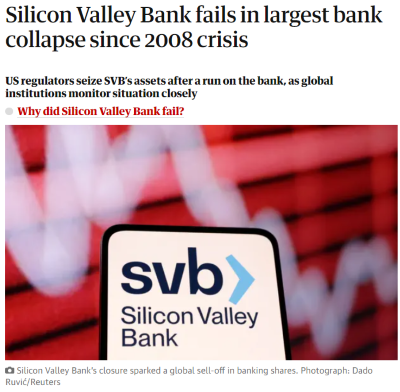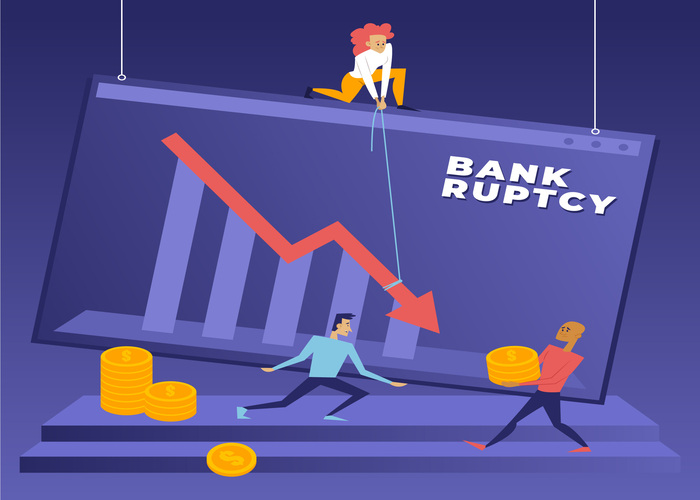If you would like to receive weekly updates like this, sign up here.
How was your weekend?
I hope you did something relaxing and took time to unwind from the travails of this world?
I mean, there’s no real need to be listening or focused on markets at such times, right?
Not much ever happens on weekends.
Oh, except for three of the biggest US bank failures of the past 20 years!
Well, I guess someone will be talking about that particular weekend for a while.
In case you missed this though (and aren’t you lucky if you did miss it?) here is one of the headlines that these collapses generated below.

Source – The Guardian
Now, I’ve got to admit that taking down one of the biggest venture capitalist banks in the US in two days takes some beating.
Then you have to wade through weeks of mass hysteria driven by the “if it bleeds, then it leads” media. But the key question if you weren’t a depositor, share or bond holder of Silicon Valley Bank (SVB) or of Silver gate and Signature banks (the other two banks involved) is this.
Should you even care about this?
Does this mark the start of financial Armageddon? In fact, isn’t this EXACTLY how the global financial crisis (GFC) began?
And what should you do with your own deposits? The media is saying that there will soon be a contagion effect. Should you be worried?
I’m here to help answer such questions today.
I will use my metaphorical crystal ball to both gaze back in time and into the future.
I call this crystal ball the 18.6-year Real Estate Cycle. And today it has one very interesting story to tell you.
So, relax, take a seat, and read on. It’s a story about how central bankers have every tool they need today to rectify this matter. And how yes, your deposits outside of these three are also quite safe.
And how utterly useless those same tools will become when the final reckoning arrives later this decade.
It was simply too good to be true, until one day it wasn’t.
So, how did we get here?
I admit it will take some time to move through the wreckage of SVB to come to a definitive conclusion of what occurred and more importantly who is to blame?
But that day will come. For now though, we can only scratch the surface for its cause.
I do however wish to venture one theory I have. And it’s this.
No-one on the board of directors of SVB was a current Boom Bust Bulletin (BBB) member back in January 2022.
Had they been, they would have known, as I explained to you in last week’s newsletter here, that the rules of investing had changed and needed to adapt to a higher interest rate/higher inflation era.
In fact, last week’s newsletter also showed you the fact the biggest and best hedge funds in the world had turned to the global macro trend of investing which is suitable for this new era.
There’s no going back to the way things were and while some (but not all) people have woken up to this, not enough people are taking this seriously.
As we have now seen.
It’s a statement of fact that for the last 18 months the US Federal Reserve has gone on the record to prep the market that it was about to embark on a rate rise campaign, one that would sustain whilst inflation was a multi-decade highs.
It is unconscionable to think the board of SVB simply ignored this advice.
Didn’t they know the US Fed was signaling to them what they should be doing moving forwards?
Ok, so what did they do instead that got them to this stage?
Again, the true details are thin on the ground, but there’s plenty of evidence to suggest the most likely culprit here.
And it explains why this is not a financial contagion catastrophe or the start of another GFC-like event.
The truth is this is a very specific example of a group of specialized lenders exposed to tech and venture capitalist start-ups. The same sector that has been the most exposed to the macro headwinds we have seen since the covid lockdowns.
However, before then it was one of the most profitable regions on earth. Silicon Valley real estate became some of the most expensive in US history. An absolute boom in tech start ups flowed to San Francisco chasing the promise of enormous riches.
Some 65,000 startups by some counts, all seeking venture capital funding to get their businesses up and running. This is the opportunity that banks like Silver gate and SVB dived headfirst into.
This was only a few years ago when interest rates were at historic lows (hard to believe that today isn’t it?). So much investment capital was raised by these businesses in the US and overseas in this tech space.
This capital was then deposited into a handful of specialist banks servicing this large sector. And it seems that the only option for these banks when it came to reinvesting these vast sums was by buying long dated US Treasury bonds. (Banking regulations required them to have safe assets on their balance sheet).
Sure, the interest rate on offer for having your money locked up for 10 years for instance was barely above 1% back then. But wholesale funding costs were almost zero, and because these bonds were treated as tier-1 capital, it was no brainier.
That same tier-1 status of its capital base allowed SVB to then approach the retail market for even more borrowing capacity.
A business model that becomes a winner for all.
And then, it seems, the US Fed’s memo to the bank simply went missing?
The worst decision at the wrong time.
Now, none of these Silicon Valley banks are considered in the same sphere as the usual US-based banking behemoths like JP Morgan for instance.
But the investments these three banks made in relation to their loan books was enormous!
Not only that, but they invested in arguably the worst kind of investment (fixed-income bonds at 1% interest) at the precise worst time (right at the start of the inflation spiking events in Ukraine and China which then forced the US Fed to start to raise rates).
Recall the loan books included Silicon Valley real estate loans, the biggest and best performing loans on earth at the time.
It was this loan book that the US Treasury tried to sell to investors over the weekend. It wasn’t the reason why the bank collapsed.
Here is SVB’s business model. They acted as the middle man between thousands of tech start ups looking for venture capital and private equity fighting amongst themselves to get involved with the next great name in tech.
SVB made one mandatory stipulation to these startups. While they were building from a great hope into an eventually profit-making business, the deposits they made must always be held with Silicon Valley Bank.
It was these deposits that were “held” via the investment in to fixed-income bonds.
Now, once the rate rises began in earnest, the book value of these bonds fell dramatically. However, its not “really” a problem if you hold them to maturity. You will in that case receive your money back, and the bank will have made a profit (albeit a small one).
The problem was, they just kept dropping in value. Eventually they were worth less than the liabilities staked against them (and it was those same deposits that were liabilities on the balance sheet).
In other words, not enough assets available to match dollar for dollar the deposits held on behalf of their customers.
Again, it’s not terminal if no large withdrawals are made.
Yeh – about that…
In a pre-empetive move the bank started to sell capital. Markets don’t like it when you sell long term assets like this on no news. This caused what I believe could very well have been the first ever all-digital bank run in US history.
$42 billion worth of withdrawals in one weekend!
This begets more selling of assets, which now realizes those paper losses into real ones. The share price reflected this vanishing of value by tanking.
Once it became clear the market wouldn’t provide further capital, the bank collapsed. This is what happened at the peak then bust of the last completed 18.6-year Real Estate Cycle to the US financial industry.
The global financial crisis.
Only, that isn’t what’s happened here. And it’s critical you understand the reason why.
Will you be ready next time?
So, just how bad is this crisis going to get?
The first thing you do is know where we are within the 18.6-year Real Estate Cycle. This tells us the true financial crisis that will badly affect global markets is many years away.
This tells me at least that this banks collapse is not systemic, it is localized in nature even though it has made worldwide news. And, most importantly of all, it’s a trap!
What do I mean?
The response from global central banks has been to step in and support depositors, either within the US or via these banks globally based subsidiaries.
It is therefore share and bond holders who will carry the can for this. But this is the market, they should understand the risks include a bank default and collapse, as unlikely as it may have been when they first invested.
But this swift action will in time stop the bank runs via withdrawals and settle things down.
Here again there is evidence that this isn’t a systemic issue. The Federal Deposit Insurance scheme covers depositors up to US $250K USD per bank account. It’s the same in Australia. (The UK’s deposit scheme is less generous, at £85k).
90% of bank customers will have deposits far under those limits. However, when it comes to Silicon Valley tech entrepreneurs and workers, that limit wasn’t enough.
These deposit accounts would have had millions in them. Remember all that VC money they had raised. It was a lot. No wonder billions disappeared from these banks over the weekend.
Again, not indicative of a system-wide issue today.
But it’s a huge trap because in a few months this bank collapse will be removed from the public consciousness. Federal authorities will pat themselves on the back for a job well done and then mistakenly believe that the next time such banks collapse, similar treatment will work.
It won’t.
Next time, there is nothing they can do to hold the system together. Thankfully, should the cycle repeat, we are years away from that day of reckoning.
My question to you is this: are you someone who has large holdings on deposit with a bank? Or are you thinking of approaching a bank to secure your next mortgage?
Perhaps you have a term deposit about to mature and not too sure if you should trust it to a bank for several years?
Has this bank collapsed caused you to rethink or pause these important decisions?
By pure chance, last week I released a new report on the current state of the entire US financial system and provided a primer on how exactly credit is created in our society.
The only way to read it is by becoming our latest Boom Bust Bulletin (BBB) member. Give me the opportunity to take you in depth into the cycle.
Learn about the over 200-year history of the 18.6-year Real Estate Cycle and why even today it continues to repeat like clockwork.
It will teach you how to decipher the news that we get bombarded with every day to focus solely on what truly matters.
No more negativity and noise, just the science of, and the timing inherent in, the real estate cycle.
This is all you need to succeed.
Don’t be surprised if news is released soon that proves bank insiders were selling their shares before the full weight of what was happening hit the news.
Don’t be surprised again if these same directors did not inform the market of these sales either. Nor that they were still paid their bonuses!
The key, as always when events like this happens, is the land market.
It’s the one missing piece from all the commentary, critical insights and general rubbish pushed out by the media when a bank like this fails.
It is why I did enjoy my weekend, safe in the knowledge that this will all blow over. A global collapse in the land market wasn’t imminent, this bank failing makes absolutely no difference.
The real estate cycle continues to turn.
How powerful is such knowledge in times like these.
Best wishes,

Darren J Wilson
and your Property Sharemarket Economics Team
P.S. – If you would like to receive weekly updates like this, sign up here.
P.P.S – Find us on Twitter here and go to our Facebook page here.
This content is not personal or general advice. If you are in doubt as to how to apply or even should be applying the content in this document to your own personal situation, we recommend you seek professional financial advice. Feel free to forward this email to any other person whom you think should read it.



